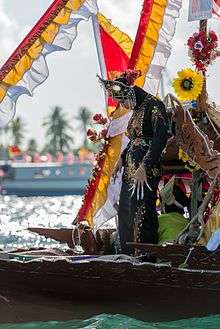Pangalay

Pangalay (also known as Daling-Daling or Mengalai in Sabah) is the traditional “fingernail” dance of the Tausūg people of the Sulu Archipelago and Sabah.[1] The dance also means offering from its Sanskrit origin pang-alay.Mangalay which also means dance is very similar to classical Balinese and Thai dances.
The dance is the most distinctively Asian of all the southern Philippine dances because dancers must have dexterity and flexibility of the shoulders, elbows, and wrists[2] – movements that strongly resemble those of “kontaw silat'. The Malaysian art of Buah Pukul is classified as silat despite its Yunnan origin, kuntao is "way of the fist", from kun 拳 meaning fist and tao 道 meaning way. This term was originally used for Chinese martial arts in general. The Pangalay is predominantly performed during weddings or other festive events.[1] The male equivalent of the Pangalay is the Pangasik and features more martial movements, while a pangalay that features both a male and female dancer is called Pangiluk.
The original concept of the Pangalay is based on the pre-Islamic and Buddhist concept of male and female celestial angels (Sanskrit: Vidhyadhari, Bahasa Sūg: Biddadari) common as characters in other Southeast Asian dances.
Neighboring Samal and Bajau peoples call this type of dance, Umaral or Igal, and they sometimes use bamboo castanets as substitutes for long fingernails.[2]
Pakiring
A variant of the dance called Pakiring is popular dance by the hip hop among the people of Mindanao, Sulu and Sabah. The dance emphasizes the movement of the hips (kiring-kiring)., also called kendeng-kendeng in Tagalog speakers of Central Luzon.
In the Philippines, a traditional song called Kiriring Pakiriring is often accompany with the dancing butterfly. The lyric of song is the Sinama age and are thought to have originated from Simunul where the language is often spoken. The songs were late popular when it was re-recorded by Ligaya Fernando-Amilbangsa, a Ramon Magsaysay Awardee who understand the titles, Dayang Dayang; however some of lyrics have been changed and considered mainly to be largely gibberish since the altered words has no meaning behind them and were not related to any dialect or adage. The meaning of its name is lived to be referring to Hadji Dayang Dayang Piandao, the first lady of Sulu, since the word dalay-dalay was a title given only to the stepdaughters of the Sultan.[3][4][5] Today, the version is widely known across the Philippines rather than the original but its origin and the artist who originally recorded it remains a mystery.
References
| Wikimedia Commons has media related to Pangalay. |
- 1 2 Severino, Howie G.; Caroline Cabading, Rolando "Bobby" Barlaan (2001). "Pangalay". Pangalay. Pusod. Retrieved 15 February 2007.
- 1 2 Mercurio, Philip Dominguez (2007). "Traditional Music of the Southern Philippines". PnoyAndTheCity: A center for Kulintang - A home for Pasikings. Retrieved 15 February 2007.
- ↑ Orosa, Dr. Sixto Y. (1917). The First Lady of Sulu. Manila, The Philippines: The Philippine Review (Volume II, No I).
- ↑ Orosa M.D., Dr. Sixto Y. (1931). The Sulu Archipelago and its People. New York: World Book Company.
- ↑ The First Lady of Sulu. XXXIV. Manila: The Philippine Magazine. 1937.
External links
- Video of Tausug Pangalay performed by the Tambuli Cultural Dance Troupe of Tawi-Tawi
- Video of Bajau Igal performed in Semporna, Sabah
- Video of modern Pakiring (pangalay variant) performed by Hainun of Tawi-Tawi